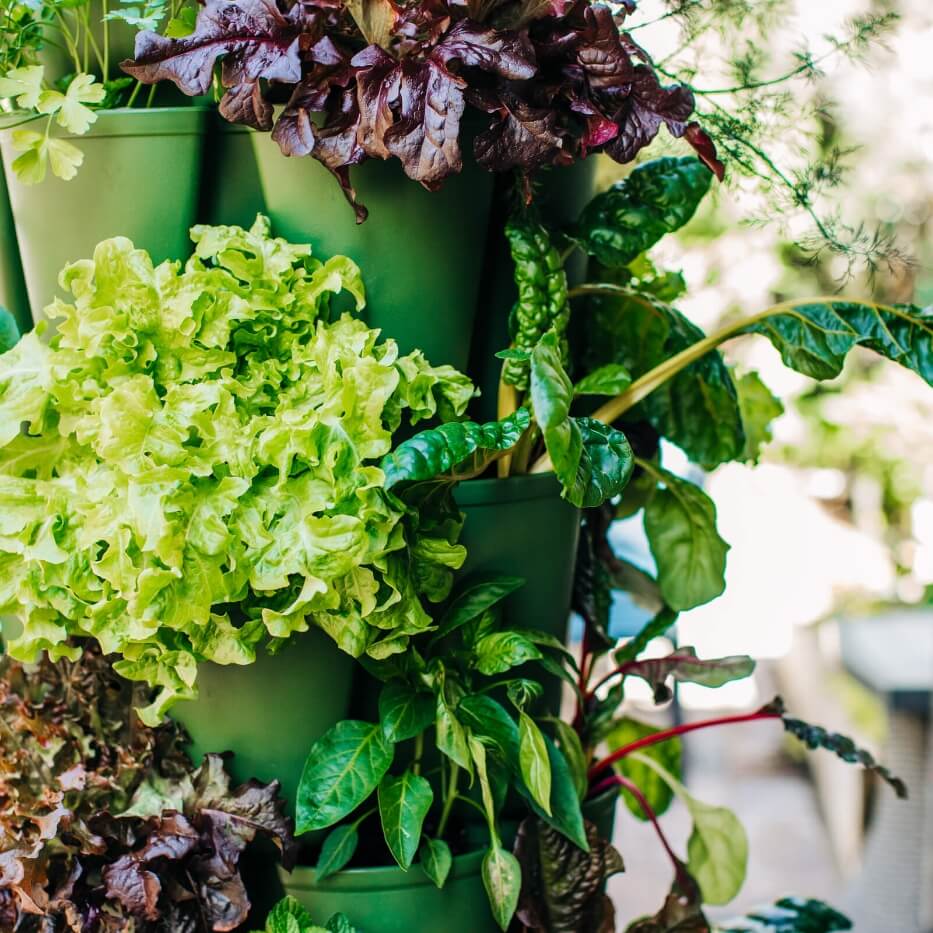Soil is the single most important decision you will make when planting your GreenStalk Vertical Planter. For many gardeners, good soil is the difference between high yields and dead plants.
If you’re like me, walking into a garden center with dozens of different brands and types of soil can be overwhelming — but romaine calm! We’re here to give you some helpful tips to guide you through the process.
Look for the word “potting.”
Typically, soil mixes that have been formulated for containers will say “potting mix” or “potting soil”. Never buy anything labeled garden soil, topsoil, or raised bed soil – those mixes are not formulated to work well with our drainage system and can lead to disappointing results.
Check the ingredients
Potting soils will contain compost, peat moss, coco coir, vermiculite, and/or perlite. They are lightweight and airy which works well in the GreenStalk. Most bags labeled “potting mix” are soilless and do not contain composted organic matter — some gardeners prefer to add compost.
When purchasing your soil, remember that not all products labeled “natural” or “organic” are actually organic! The USDA does not regulate soil as it does food. Good quality soil or true organic soil will be more expensive than the fake stuff. You might have to do some research to know what you are getting is quality. Most bags labeled as organic soil are organic, but if it has the OMRI certification, you can trust that it is actually organic.
Check the texture
A good mix will be smooth and lightweight. You’ll be able to easily break it apart and it will absorb water quickly. If there are big chunks of wood, it’s hard to break apart, or the bag is super heavy, pass. There are so many good potting mixes out there — don’t waste your money on cheap imitations.

Compare sizes
The GreenStalk Original Vertical Planter uses 1 cubic foot (or 8 gallons) of soil per tier – that’s a lot of soil! All bags are not created equal. Small bags are easier to handle and may be worth the cost difference depending on your preference. If you’re looking for the biggest bang for your buck, go for the big bags! Some bags will be labeled in gallons or even quarts, so you may need to pull up a conversion chart online if you’re at the store and unsure how much you need.
Reuse your soil
You can reuse your soil. If you’ve already grown in your GreenStalk the previous season, you’ll want to remove any large roots from the soil; the smaller roots will break down in the soil and not cause any issues. It’s always a good idea to amend and loosen used soil with each new season. We amend and re-use soil many times but also use fresh as well. If your soil didn’t perform well or your plants had a disease, it’s best to start fresh. You can read all about how to reuse your potting mix here.
Soil is an investment
When buying your soil, you need to keep in mind that you get what you pay for, and buying a good potting mix is a sound investment. There’s nothing worse than buying seeds, planters, soil, planting your garden, and carefully watering it, only to realize that the soil is no good. It’s incredibly frustrating and defeating to put in all that work only to be sabotaged from the beginning. A good potting mix is invaluable and certainly worth the minimal extra cost rather than losing an entire crop and season. Tip: Pay attention to the units of measurement! The cheaper bags are not always cheaper when you do the conversion.
Ask for help
If you are unsure what type of soil to get, ask your local garden center. Nurseries and garden centers in your area are a wealth of information on what works best in your particular climate. If you’re at a big box store, look up reviews online by simply searching the brand. There may not be a lot of reviews on every potting soil, but you will definitely see reviews if people have had a bad experience. Below are some recommendations by brands that we’ve used or our customers have used with favorable results:
- Happy Frog Potting Soil
- Pro-Mix Potting Mix
- Espoma Potting Mix
Consider fertilizer
Finally, after you’ve chosen your potting soil, you will need to consider fertilizer. Many potting soils have built-in fertilizers and you won’t need to add any granular fertilizer at planting. You should add fertilizer if you’re making your own potting soil, using potting soil that does not have built-in fertilizer, or amending previously used potting soil.
To keep your plants fed, use a liquid fertilizer like Fox Fam Grow Big one to two months after planting.
That wraps up our list! For more info on choosing the right soil, email us at support@greenstalkgarden.com. You can also join our GreenStalk Gardener’s Group on Facebook to learn about what soils our customers prefer.



































